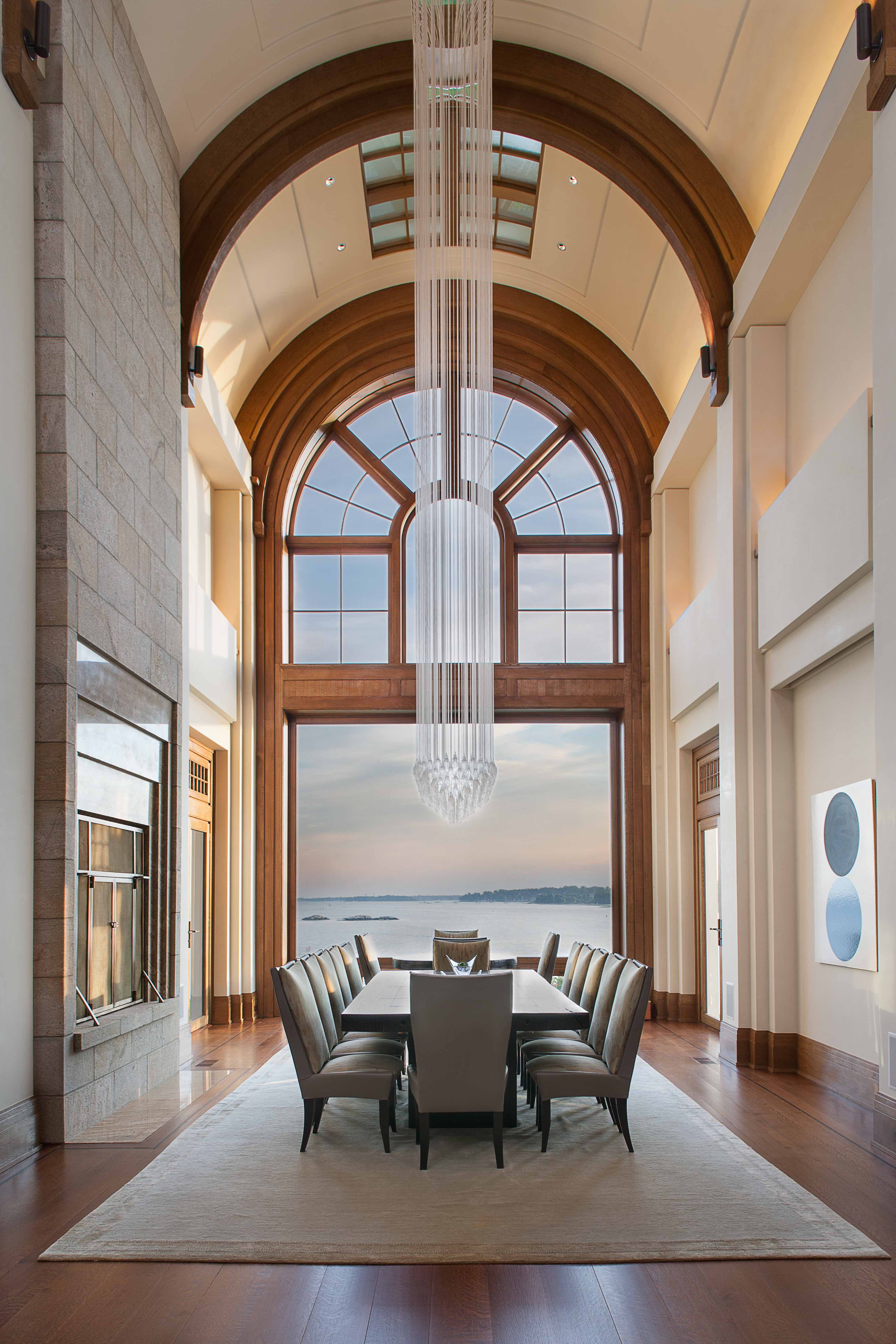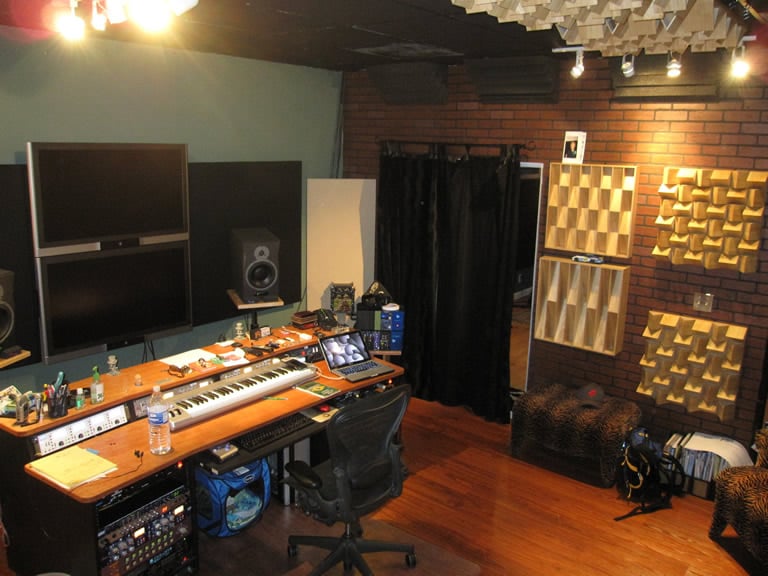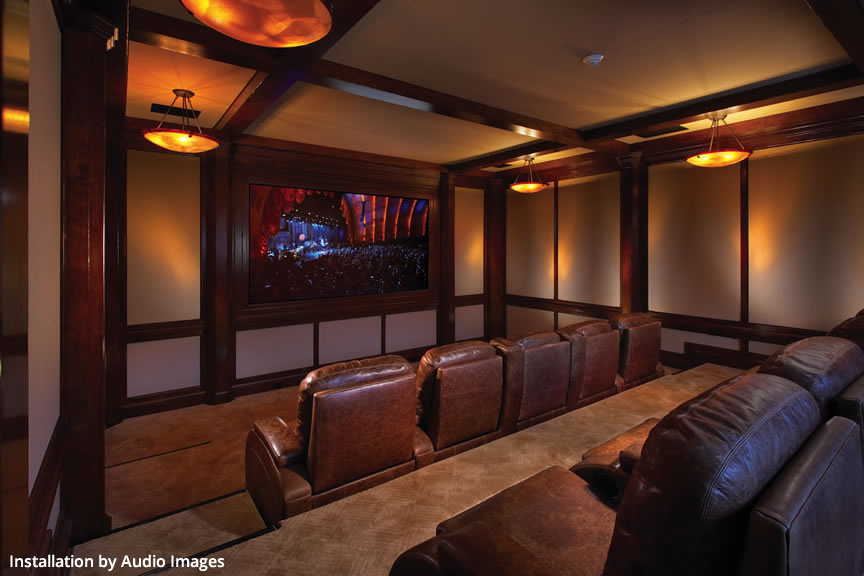
|
| Vaulted ceilings can cause sound to run rampant if unaddressed. Image courtesy of SH Acoustics. |
Have you ever been on a home tour and heard the Realtor touting excellent acoustics, expounding the virtues of sound isolation, or extolling the benefits of minimal reverberation? Probably not. Acoustics are usually relegated to afterthought status, with a simple, “oh, and this is a very quiet street,” tacked on at the end of the conversation.
However, acoustics are crucial to long-term health and wellness, and homeowners are becoming more aware of this due to the pandemic. COVID has caused them to not only take a hard look at their health for obvious reasons but has forced them to spend dramatically more time at home, creating conditions that coincide to encourage home wellness awareness. From indoor air and water quality to circadian rhythm lighting to acoustics to biophilic design to cinematherapy, homeowners are now taking notice of all the ways their home can contribute to or detract from good health.
Until now, there have been limited efforts made by the various trades to control sound in the home because “you can’t see sound, and if it’s not visual or tactile, it doesn’t resonate,” says Steve Haas, owner of SH Acoustics and coiner of the term acoustic wellness. “This has a domino effect because trades aren’t pushing the concept of acoustic wellness to their clients, who are therefore generally unaware of the negative effects of noise. Likewise, modern wellness technology manufacturers and service providers don’t address acoustics, but focus on water, air quality, and lighting as the trinity of home wellness. But acoustics needs a place at the table.”
Bad Acoustics Trigger Fight or Flight Response
Bad acoustics and noise deliver a level of constant, insidious stress that has harmful effects on your health over time. Worse, you may not even consciously realize that anything is amiss.
But your body sure does. Anthony Grimani, owner of PMI Engineering, MSR Acoustics, and Grimani Systems, explains: “We are all equipped with a 3D acoustic radar that we use to detect if situations around us are dangerous. Bats navigate by echolocation, creating an acoustic picture of their environment. As an element of survival, we also subconsciously listen to sounds bouncing around. In a cave, you will hear a bear’s growl and try to place its location, and your body’s fight-or-flight response will trigger to keep you safe.”
We’ve since moved out of caves, but our homes are just as filled with sound reflections. In a contemporary abode filled with concrete, stone, high ceilings, and big open spaces, sound bounces off these reflective surfaces and arrives at your ears in a confusing way. Reverberations cause you to expend precious brainpower and trigger catecholamine hormone secretion, the fight-or-flight hormone. Your brain is trying to locate the sound to determine a threat, just like it did in the cave all those years ago. This happens automatically, even in the place where you should feel most at ease—your own home.
“Because your brain is in a constant ‘alert mode’ when sound reflections assail your ears from all directions, it doesn’t know what to listen to, and your sense of safety tells you that a highly reflective home is actually a dangerous place,” says Grimani. “This makes it hard to relax because all the blood is moving into your legs and arms, preparing you for flight or fight and causing cerebral processes to shut down.”
In a residential environment, this might translate to you feeling agitated and leaving a house party early and not understanding why. In a restaurant, it might result in you skipping dessert—a travesty in and of itself—or having a bad and distracted conversation on a date or in a meeting where first impressions are everything. Not so great for your love life or career.
Unfortunately, this acoustic dis-ease can be much more concerning than a bad date or a meh party. It is possible that it actually causes disease when there is compounded stress over time due to constant unaddressed negative acoustic spaces present in your living conditions.
Sound can disturb sleep, cause cardiovascular and psychophysiological effects, affect hearing, reduce performance, and provoke annoyance responses and changes in social behavior.
—The World Health Organization
Haas is no stranger to working in commercial spaces like those unfortunate ones we mention above. He has spent a large portion of his career studying human behavior in various types of commercial spaces, before he jumped into the residential market in the mid ‘90s. “I was an observant student of people in public spaces like museums, where patrons and employees are bombarded with different media programs. The quality of sound in these environments can be beneficial to visitors’ comfort and experience; or it can be detrimental, a cacophony of sounds that causes them to run out of the space with their hands over their ears.”
Haas became an expert on ameliorating those negative experiences in spaces like the Statue of Liberty Museum and the United States Holocaust Memorial, using acoustic and audio design strategies to retain patrons and ensure employee comfort. Likewise, he has translated that commercial experience to the residential market, where he has been making it his mission to influence the trades envisioning and creating spaces for homeowners to elevate the importance of acoustics with their clients. “Finally, homeowners are beginning to bring acoustic design to the table as something that is important to them, propelling the conversation with designers and architects forward.”
Long-Term Effects of Noise and Poor Acoustics
The World Health Organization (WHO) has published stats and studies that show how dire the effect of noise is on our health. According to the WHO, excessive noise “seriously harms human health” and interferes with people’s daily activities at school, at work, at home, and during leisure time. It can disturb sleep, cause cardiovascular and psychophysiological effects, affect hearing, reduce performance, and provoke annoyance responses and changes in social behavior. The Environmental Protection Agency under the Clean Air Act has also established the Office of Noise Abatement and Control (ONAC) to carry out investigations and studies on noise and its effect on public health and welfare.
A noisy environment can come from a variety of factors in the home, such as the HVAC operating or humming from a light dimmer,” says Haas. “But you also have other noises like dogs barking and kids yelling, and all have an effect on your daily stress levels.”

|
| Home recording studios are more popular in a COVID world, and need to be specially treated for acoustics. Image courtesy of PMI. |
Haas goes on to say that most homeowners do not know what’s wrong with the sound in their home, nor what they can do to control it. Enter the acoustic designer. SH Acoustics, for example, does an assessment specific to a homeowner’s existing space or based on new home plans. The company looks at the home with an acoustic ear, identifies existing or potential problems, and determines what concerns the homeowner has and to what degree, honing in on acoustic needs much like an architect would survey a new client to determine their design preferences.
“We assess how sound will travel and behave, and the effect on the homeowners’ health and wellness,” says Haas. “We balance the acoustic design of a home, apartment, townhouse, or yacht with the noise level that the homeowner is comfortable with.”
Likewise, Grimani works closely with homeowners and their contractors in acoustical and audio-video engineering and design, surveying the homeowner to determine their acoustic goals. “How important is the room and how often will it be used? Do they want optimal acoustic performance for sound quality or simply to contain the sound? These are all questions we ask the homeowner,” says Grimani.
Sound Quality and Sound Containment
Sound quality (performance) addresses all the needs and functions of the space. “It’s about how you want the sound to behave and how to tame it, having precision control over the room’s sound character,” says Haas. Performance spaces, such as a home theater, media room, live residential concert space, or listening room, must be acoustically designed for optimal performance.
“If you put expensive loudspeakers in an untreated room with 14-foot ceilings, the music will not sound good, no matter how great the speakers are,” says Grimani. “When we design a home cinema, we don’t just throw a speaker into a room. We treat the acoustics and create a room that has high Sound Comfort. Many clients, in fact, tell us that they go into their home theater to relax or chat because it is so comfortable.”
Even though acoustics is not a piece of hardware or software, it is every bit a part of the sound system. The takeaway: significantly investing in an expensive audio system but not considering the room’s acoustics is like “having an amazing piece of fresh fish just caught from the sea, but then cooking it improperly. You may as well buy fish sticks from the frozen section,” says Grimani.

|
| There are two areas that acoustic designers address in residential environments: sound quality and sound containment. High-performance spaces like this home theater by Audio Images and PMI are designed for both. Image courtesy of PMI. |
Another social side effect of COVID is an interest in at-home performance spaces as live venues around the world remain closed. Haas has been designing residential live performance systems using SH Acoustics’ Concertino speaker system and acoustics for many years. Grimani also designs live performance spaces and home recording studios. “With a well-designed live concert system including acoustic design, homeowners can produce mini-concerts for family or friends who’ve been quarantining,” says Haas. “This is part of the new normal for live music, all of which is tied into socializing and human connection, a key element for holistic health.”
Sound containment or isolation is when sound is generated in one room and you do not want it to be heard in another, and to what degree. “We don’t like the word ‘soundproofing,’ because unlike waterproofing where you hope that no water is getting in, a homeowner can decide how much or little sound they require to feel comfortable,” Haas adds. “A completely acoustically ‘dead’ room is not necessarily a comfortable space.”
Sound containment in the bedroom is essential to health because noise can disrupt sleep cycles. Street noise, like the sound of a garbage truck picking up trash at 6 am, and interior noise, such as a teenager playing music in an adjacent bedroom, can be problematic if not contained.
Likewise, a high-performance home theater in the basement needs to be isolated to keep audio from spreading into the rest of the home and vice versa. Many homeowners with existing home theaters have their private cinemas serving double-duty as work-from-home and learn-from-home spaces during COVID because they are acoustically treated and, therefore, are much quieter than other rooms in the home.
In fact, quarantine has underscored how important sound isolation in home-office and learn-from-home spaces is. It is a well-established fact that noise is distracting for students and downright embarrassing in work-from-home situations.The dog barking incessantly at the mailman during your Zoom might have been acceptable back in March, but is not so cute eight months into quarantine. Likewise, kids playing in the yard outside your office make it hard to focus. Addressing acoustics in your home office goes beyond the issue of wellness; it’s also about productivity and professionalism.
In outdoor spaces, leaf blowers, lawn mowers, highways, condensers, generators, and local construction can upset tranquillity. Even unenclosed areas, such as an outdoor pool, garden, or patio, can be treated to create a more peaceful environment, blocking out noise from a busy street using acoustic techniques like barrier fences and noise cancellation.

|
| Hard surfaces can cause sound reflections if left untreated. Image courtesy of SH Acoustics |
What Does Acoustic Design Cost?
Lighting design and thermal comfort took 50 years to evolve into their current states, and are now both at the forefront of the wellness movement. Acoustic wellness, as Haas calls it, or Sound Comfort, as Grimani dubs it, is what’s next in residential wellness. But how much should you expect to pay for acoustic design services?
Every acoustic design is unique to the acoustician, the individual home, the noise level, the homeowner’s preferences, audio-video specifications, and other factors. Haas says, however, that you can generally expect to pay 5-7% in upgraded construction costs in whole-house acoustic and wellness design throughout the residence. From a performance perspective, the acoustic design of a home theater or media room should be part and parcel of the original equipment quote.
If you are working with a professional home technology integrator, such as an HTA Certified firm, loop in the acoustician early in the process. If your new home or remodel involves an architect or interior designer, it’s likewise important to bring an acoustician into the conversation from the earliest stage possible. Design decisions profoundly affect acoustics, so having the acoustician involved from the beginning helps eliminate potential acoustic issues before they exist, saving time and money.
An investment in acoustics delivers more than just a boost in your home value; it is an investment in your health. The inhabitants’ serenity and long-term health, prevention of stress-related disease, and overall comfort are priceless...and that sounds pretty healthy.



























